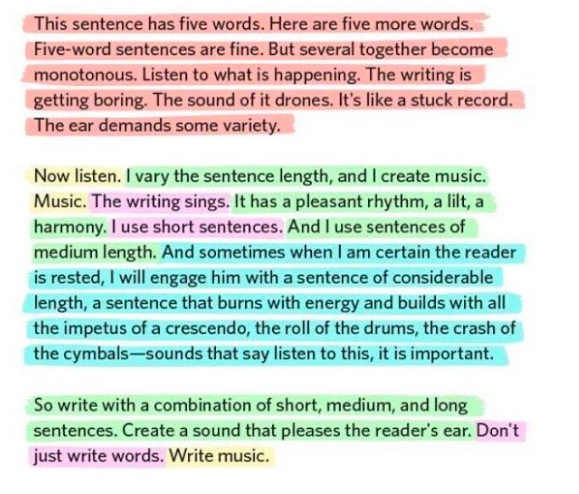
In our blogging breakthrough sessions, many of our clients have shared the same issue when it comes to getting their blog out there. You just don’t feel confident to hit publish.
First, I want you to know this isn’t exclusive to the blogging breakthrough course. The confidence barrier pops up in our accelerator sessions, in our mastery group, in our client calls. It’s a shared feeling amongst ambitious accountants, even if the underlying reasons for it are different from person to person, experience to experience.
Publishing anything online can feel scary and exposing. There may be some deeper rooted insecurities you’re battling with when it comes to sharing your content publicly. But part of the issue can be resolved just by having an editing process you can rely on, so you feel confident your first draft is polished and ready to be seen.
Start by going away and getting space from your first draft
Once you’ve written your first edition / brain mess / sh*tty first draft – take yourself away from it. Scram! I mean it. This is like blogging self care. If you allow yourself space from your words for a while, you’re able to get some perspective, mull over what you really want to say and come back with fresh eyes.
I find going for a run really helpful right after a first draft. Maybe it’s increased blood to the brain or the mindful nature of the miles, but something about hitting the pavement clears the fog and gives me greater clarity on the purpose of a piece. It may not be running for you. It might be walking, getting lunch, or taking the dog around the block. It might simply be helpful to get on with a completely different task for a while. Whatever way you process best, take. the. break.
When you come back with those fresh eyes…
1. Read it out loud – see if it sounds like you
The reason I suggest reading your blog back to yourself out loud, is because you can hear whether or not it sounds human. Most importantly, whether it sounds like your brand and your voice. We encourage our clients to write like they speak, because otherwise you can end up ‘over-professionalising’ your blogs.
It’s completely understandable, since many of you have come from a background of formal letter writing and financial advising. It can feel unnatural at first to be ‘informal’. But remember your purpose for writing a blog is simply to help your clients.
Some of the best content I’ve helped clients write has come from a talk-it-through zoom meet or video. Because I’m not an accountant, our clients will naturally explain things to me in conversation, in terms I understand and can relate to. Those in-person conversations are what you want to emulate when you’re writing and editing your blog.
You be the judge of you. Read your blog back and ask yourself:
“Am I trying to “be more professional” or sound a certain way? Or am I actually answering the question the way I would if I were sat with a client?”
And if you’re struggling to be the judge of you – send the blog to someone you trust. A friend, a client you love, a member of your team. The PF team is always here to offer reviews and help you hone your piece. We set up our content review community for exactly this reason.
2. ‘Trim the fat’ – cut out the waffle and the filler words
Make like your blog is a thanksgiving turkey, and take a carving knife to your draft.
There will be sentences you don’t need in there, a few unnecessary words and some points you’ve repeated a few times. And it’s okay, by the way. We actively encourage clients to get all their thoughts and notes down on the page for a first draft. There’s a time and place for letting your thoughts loose, and there’s a time and place for reining them in. The time is now.
- Look out for any areas you just said the same thing a different way.
For example:
[Title] What is cash flow, and why is it so important?
“In this blog we want to talk about the importance of cash flow. Because cash flow is so important to your business..”
Change to:
[Title] What is cash flow, and why is it so important?
Cash flow is the flow of money coming in and out of your business each month. If more money is going out than coming in, your business could be in danger.
Instead of repeating the question in the title, you get straight into the answer.
- Get to the point – Remove any waffle and say what you need to say
“We know that you are the kind of business owner who thinks hard about making decisions before you make them…”
Change to
“Before you make decisions, you think hard about…”
Try not to use words just to fill space. Cut out all the “you maybe might want to’s” and just straight up say “you will”. Getting to the point is more readable for your prospect, because they don’t have to take as many words in. It also shows your authority on the subject, and demonstrates you have a real understanding of your prospect and their experiences.
- Get your primary school teacher out of your head
This was the first (and arguably) best advice I was given by a university lecturer when I went to study creative writing.
We were taught lots of grammar rules and restrictions in our school education. Some of it has come in useful, for sure. Some of it becomes outdated and unnecessary when you’re writing a blog for your clients many moons later.
You can remove words like henceforth and moreover. You can start a sentence with ‘And’ or ‘But’. You can use ‘don’t’ instead of ‘do not’. If you’re British, you can probably drop the archaic ‘whilst’ in favour of ‘while’ now.
Remember, write like you speak. I hope this frees you, like it did me!
- Check for any of your ‘forbidden’ words unsuited to your brand
At PF, we try our best to never use the word ‘should’ in any of our communications with you. We love educating accountants in marketing, so they can understand and love it. For this reason, ‘should’ is a shaming word to us. Saying “You should do this” wouldn’t suit our ethos of learning.
Are there any words or phrases you feel don’t suit your values or your ethos? It can help to identify and document these first, so you and your team always have something to reference against. If you already have your values, sit down with your team and identify your tone of voice. Here’s a great blog to help you. We’ve run some wonderful sessions with our clients and their teams to help them define their voice – we’re here if you’d prefer to be guided to it.

3. Format your blog so it’s easy for lazy readers to get the point
It’s all well and good having an amazing piece of content to answer the burning questions you’re being asked. But if it’s long and not easily readable, it’ll have less impact. Unfortunately, we humans are lazy readers. We skim content fast to decide whether we want to settle into it.
It’s absolutely fine (and even recommended) to have a blog be 1500+. If those 1500 words are super valuable, it’ll get read. Make some edits to your text so the content is easy to consume.
- Break up paragraphs into 3-4 sentences
- Vary your sentence lengths – I love this quote from Gary Provost on writing with a rhythm (quoted in Writing Tools: 50 Essential Strategies for Every Writer by Roy Peter Clark):

- Pepper the blog with bullet points, numbered lists and images where you can, to break up lengthy text.
- Make your headers ‘match
For example:
Header 1 – A cash flow forecast will help you see how much money you’ll have
Header 2 – What you need
These aren’t consistent. Think of the reader who is flicking past it on their phone. What will they see in what order? You don’t always have to make them match in tense, but each header must make a point to contributes to the overall purpose of the blog. it’s easier for the person who is skimming it fast. Look back at the headings in this marketing tip as an example.
- Make sure the headers are action-focused – “Tracking your numbers” is not an action header or a statement. It’s vague. Remember headers, if read in order without any of the rest of the content, still tell a clear story. If they didn’t read the whole blog but only read the headers, would they roughly have what they needed on this topic? Would it draw them in to find out how?
Once you’ve edited once or twice, hit the damn button
Your blog doesn’t need to be perfect to be done. You might use these tips to edit your blog once or twice, but then you’ve just got to do the brave thing and publish. The aim of this isn’t to become a perfectionist, it’s to feel confident you’ve answered a client’s question in the best way possible for them.
Remember, you’re just trying to help your clients through a problem, so they can do better business. This isn’t for your peers in the accounting world, don’t worry about them. You wouldn’t have them approve your meeting notes before having coffee with a client. In the same way, you don’t need their approval for your blog.
Once you’re happy your blog is edited and ready to go, here’s a useful blog to help you decide where and how to share it.
If you’re feeling like you need a little more marketing therapy to help you break down your blogging barriers, we’d love to have you on our next blogging breakthrough. It’s a small intimate group, and we cover the four key hurdles: Thinking of ideas, getting the thing written, editing your first draft, publishing and knowing where to share.
You’ve got this!

